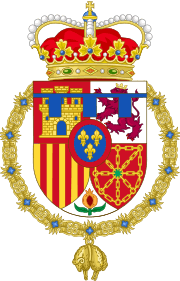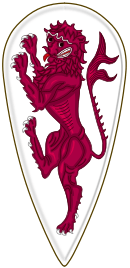Henry III of Castile
| Henry III | |
|---|---|
 Image of King Henry III of Castile, 15th c. stained glass. | |
| King of Castile and León | |
| Reign | 9 October 1390 – 25 December 1406 |
| Predecessor | John I |
| Successor | John II |
| Born |
4 October 1379 Burgos |
| Died |
25 December 1406 (aged 27) Toledo |
| Burial | Cathedral of Toledo |
| Consort | Catherine of Lancaster |
| Issue Detail |
Maria, Queen of Aragon Catherine, Duchess of Villena John II, King of Castile |
| House | House of Trastámara |
| Father | John I, King of Castile |
| Mother | Eleanor of Aragon |
| Religion | Roman Catholicism |
Henry III of Castile (4 October 1379 – 25 December 1406), called the Mourner (Spanish: Enrique el Doliente, Galician: Henrique o Doente), was the son of John I and Eleanor of Aragon. He succeeded his father as King of Castile in 1390.
Birth and education
Henry was born in Burgos, the capital of Castile. He was the first-born child of the recently crowned king John I of Castile and his wife Eleanor of Aragon. His younger brother Ferdinand grew up to become king of Aragon.
His upbringing was entrusted to Inés Lasso de la Vega, the wife of John Niño. As a child he was educated by Diego de Anaya Maldonado, Bishop of Tui-Vigo, who later became Archbishop of Seville. His tutor was Juan Hurtado de Mendoza el Limpio and his confessor was the Dominican Alonso de Cusanza, who later became Bishop of Salamanca and León.
Marriage
Shortly after his birth, he was promised to be married to Beatrice of Portugal, the heir to the Portuguese throne. This was part of a peace treaty between Castile and Portugal, who had signed a truce after the Ferdinand Wars. But this marriage did not happen. Instead, Beatrice married his father, who would instigate a war of succession with John of Aviz.
In 1388, as part of the Treaty of Bayonne, he married Catherine of Lancaster in Palencia Cathedral. She was the daughter of John of Gaunt, the Duke of Lancaster, and Constance of Castile, a daughter of Peter the Cruel. This solved the dynastic conflict that had raged since the death of Peter the Cruel, secured the House of Trastámara, and established peace between England and Castile.
Prince of Asturias
At the time of his wedding, he received the title Prince of Asturias with the approval of the court of Briviesca. This title designated him as the heir apparent. He was the first person to hold this title, with earlier heirs to the throne being known as infantes mayores.
In 1390, his father considered abdicating in his favour to gain the recognition of the Portuguese, but he was dissuaded from this plan by his council. They were against it because of the damage caused to the kingdom by earlier similar decisions. However, in October of the same year, King John died in Alcalá de Henares by falling off his horse, and Henry was proclaimed king.
He assumed power on 2 August 1393, at the age of 13, during a tumultuous period of changes in the regency.
Reign
Despite his nickname, he engaged in a vigorous foreign policy and manoeuvres during the first few years of the 15th century. He was able to pacify the nobility and restore royal power.
He was supported by the aristocracy and displaced their most powerful relatives (such as Alfonso Enríquez and his aunt Eleanor). He repealed privileges granted by his predecessors at the Court of Castile, such as the alcabala (a heavy sales tax) and the right to attend the council. He increased the number of city magistrates[1] and cleaned up the kingdom's economy. He reduced persecution of the Jews and passed various bills against the violence, which had become particularly bad by 1391.[2][3]
During his reign, the Castilian fleet won several victories against the English; Henry sent a naval fleet in 1400 that destroyed Tétouan in North Africa, a pirate base. In 1402, Henry began the colonisation of the Canary Islands, sending French explorer Jean de Béthencourt. He deflected a Portuguese invasion with an attack on Badajoz in 1396, finally signing a peace treaty with John I of Portugal on 15 August 1402.
He supported the papal pretension of Antipope Benedict XIII. He restarted the conflict against the kingdom of Granada, winning a victory at the Battle of Collejares, near Úbeda, which freed the town in 1406. However his untimely death in the same year prevented him from completing this campaign.
He also sent Payo Gómez de Sotomayor and Hernán Sánchez de Palazuelos, and later, on 21 May 1403, Ruy González de Clavijo, as ambassadors to Timur to discuss the possibility of an alliance between Timur and Castile against the Ottoman Empire.[4] The latter recounted his travels in a book, Embajada a Tamorlán.
Due to his poor health, he delegated part of his power to his brother Ferdinand I of Aragon in the later part of his reign, who became regent while Henry's son John II of Castile was too young to rule.
Henry died in the city of Toledo on 25 December 1406, while preparing a campaign against the Emirate of Granada.[5]
Tomb

After his death, Henry's body was taken to the city of Toledo, which he was interred in a tomb in the Chapel of the New Monarchs of the Cathedral of Toledo, and his remains are still there today.[6] The tomb is located above the choir stalls on the Gospel side and is in the Plateresque style. The box part is decorated with the shields of Castile and León, and the lower interior has three panels decorated with trophies. Above the three panels two cherubs hold a plaque on which is engraved the Monarch's epitaph:[7]
"AQUI IACE EL MUI TEMIDO Y JUSTICIERO REI DON ENRIQUE DE DULCE MEMORIA QUE DIOS DE SANTO PARAISO HIJO DEL CATHOLICO REI DON JUAN NIETO DEL NOBLE CAVALLERO DON ENRIQUE EN 16 AÑOS QUE REINO FUE CASTILLA TEMIDA Y HONRRADA NACIO EN BURGOS DIA DE SAN FRANCISCO Y MURIO DIA DE NABIDAD EN TOLEDO IENDO A LA GUERRA DE LOS MOROS CON LOS NOBLES DEL REINO FINO AÑO DEL SEÑOR DE 1407." (Medieval Spanish language)
Which translates to:
Here lies the very feared and justice-maker king Henry, of sweet memory, may God give [him] the Holy Paradise, [he was] son of the Catholic King John I and grandson of the noble knight Henry[.] In the 16 years he reigned, Castile was feared and honored[. He] was born in Burgos on the day of St Francis and died on Christmas Day in Toledo, going to the Moors war with the kingdom's nobles, finishing AD 1407.
There is a recumbent statue of Henry III over the tomb, made in polychrome alabaster. Henry appears clothed in a Franciscan habit, although his hands are holding his sword in his girdle, which runs parallel to the Cordón de San Francisco. The king's head in his crown rests on three rich cushions, and his feet are bare. Four kneeling angels are at the corners of the statue.
Marriage and issue
In 1388, Henry married Catherine of Lancaster (1372–1418), the daughter of John of Gaunt, 1st Duke of Lancaster, and Constance of Castile, who was the elder daughter of King Peter. This ended a dynastic conflict and solidified the House of Trastamara. Their marriage ceremony took place in Palencia Cathedral and they had three children:
- Maria (1401–1458), wife of Alfonso V of Aragon and Queen of Aragon
- Catherine (1403–1439), wife of Infante Henry, Duke of Villena
- John II (1405–1454), King of Castile
Ancestry
| Ancestors of Henry III of Castile | ||||||||||||||||||||||||||||||||||||||||||||||||||||||||||||||||||||||||||||||||||||||||||||||||||||||||||||||||||||||||||||||||||||||||||||||||||||||||||||||||||||||||||||||||||||||||||||||||||||||||||||||||||||||||||||||||||||||||||||||||||||||||||||||||||||||||||||||||||||||||||||||||||||||||||||||||||||||||||||||||||||||||||||||||||||||||||||||||||||||||||||||||||||||||||||||||||||||||||||||||||||||||||||||||||||||||||||||||||||||||||||||||||||||||||||||||||||||||||||||||||||||||||||||||||||||||||||||||||
|---|---|---|---|---|---|---|---|---|---|---|---|---|---|---|---|---|---|---|---|---|---|---|---|---|---|---|---|---|---|---|---|---|---|---|---|---|---|---|---|---|---|---|---|---|---|---|---|---|---|---|---|---|---|---|---|---|---|---|---|---|---|---|---|---|---|---|---|---|---|---|---|---|---|---|---|---|---|---|---|---|---|---|---|---|---|---|---|---|---|---|---|---|---|---|---|---|---|---|---|---|---|---|---|---|---|---|---|---|---|---|---|---|---|---|---|---|---|---|---|---|---|---|---|---|---|---|---|---|---|---|---|---|---|---|---|---|---|---|---|---|---|---|---|---|---|---|---|---|---|---|---|---|---|---|---|---|---|---|---|---|---|---|---|---|---|---|---|---|---|---|---|---|---|---|---|---|---|---|---|---|---|---|---|---|---|---|---|---|---|---|---|---|---|---|---|---|---|---|---|---|---|---|---|---|---|---|---|---|---|---|---|---|---|---|---|---|---|---|---|---|---|---|---|---|---|---|---|---|---|---|---|---|---|---|---|---|---|---|---|---|---|---|---|---|---|---|---|---|---|---|---|---|---|---|---|---|---|---|---|---|---|---|---|---|---|---|---|---|---|---|---|---|---|---|---|---|---|---|---|---|---|---|---|---|---|---|---|---|---|---|---|---|---|---|---|---|---|---|---|---|---|---|---|---|---|---|---|---|---|---|---|---|---|---|---|---|---|---|---|---|---|---|---|---|---|---|---|---|---|---|---|---|---|---|---|---|---|---|---|---|---|---|---|---|---|---|---|---|---|---|---|---|---|---|---|---|---|---|---|---|---|---|---|---|---|---|---|---|---|---|---|---|---|---|---|---|---|---|---|---|---|---|---|---|---|---|---|---|---|---|---|---|---|---|---|---|---|---|---|---|---|---|---|---|---|---|---|---|---|---|---|---|---|---|---|---|---|---|---|---|---|---|---|---|---|---|---|---|---|---|---|---|---|---|---|---|---|---|---|---|---|---|---|---|---|---|---|---|---|---|---|---|---|---|---|---|---|---|---|---|---|---|---|---|---|---|---|---|---|---|---|---|---|---|---|---|---|---|---|---|---|---|---|---|---|---|---|---|---|---|---|---|---|---|---|---|---|---|---|---|---|---|---|---|---|---|---|---|---|---|---|---|---|---|
| ||||||||||||||||||||||||||||||||||||||||||||||||||||||||||||||||||||||||||||||||||||||||||||||||||||||||||||||||||||||||||||||||||||||||||||||||||||||||||||||||||||||||||||||||||||||||||||||||||||||||||||||||||||||||||||||||||||||||||||||||||||||||||||||||||||||||||||||||||||||||||||||||||||||||||||||||||||||||||||||||||||||||||||||||||||||||||||||||||||||||||||||||||||||||||||||||||||||||||||||||||||||||||||||||||||||||||||||||||||||||||||||||||||||||||||||||||||||||||||||||||||||||||||||||||||||||||||||||||
References
- ↑ Mitre Fernández, Emilio (1969). Secretariado de Publicaciones e Intercambio Editorial, ed. Extensión del régimen de corregidores en el reinado de Enrique III de Castilla [The extension of the magistrates during the reign of Henry III of Castile] (in Spanish). Valladolid University. ISBN 84-600-0218-7.
- ↑ Mitre Fernández, Emilio (1994). Secretariado de Publicaciones e Intercambio Editorial, ed. Los judíos de Castilla en tiempo de Enrique III : el pogrom de 1391 [The Castilian Jews at the time of Henry III: the 1391 pogrom] (in Spanish). Valladolid University. ISBN 84-7762-449-6.
- ↑ A historical record of great importance is found in Solomon ibn Verga's book, Shevat Yehudah, Lvov 1846 (p. 76 in PDF), where the author mentions in the name of Rabbi Shem Tov, the son of Shem Tov Sukkam, that in the year 5150 anno mundi (a year corresponding with 1390 of our Common Era), during the reign of King Henry III (Don Enrico), while he was still a youth, many of the local Spaniards had risen-up to force the nation of Israel in Spain to abandon their fathers' religion and to embrace Christianity, and that the people oppressed the Jews and beat them with severe beatings. Subsequently, many Jews in Spain abandoned their religion, especially (using his own words) "the great Jewish congregation at Seville, most of whom choosing to become Christians" instead of enduring their afflictions. Likewise, the Jewish communities in Córdoba and in Usún (a place in Navarra) gave-in to pressure and many converted, as did all of the region of Andalucía, besides many other great cities, such as Ocaña (in Andalucía), Escalona (in Castille) and Torrijas (in Aragon), among other places expressly mentioned by name. He adds that their sufferings were so great that it is not fitting to make mention of them because of their bringing utter "terror to the hearts" of those who should hear them.
- ↑ Montojo Jiménez, Carlos (2004). La diplomacia castellana bajo Enrique III : estudio especial de la embajada de Ruy González de Clavijo a la corte de Tamerlán [Castilian diplomacy under Henry III: a special study of Ruy González de Clavijo's embassy to the court of Timur] (in Spanish). Ministry of Foreign Affairs. Centro de Publicaciones. ISBN 84-95265-38-9.
- ↑ Mitre Fernández, Emilio (2001). Una muerte para un rey : Enrique III de Castilla (Navidad de 1406) [A King's death: Henry III of Castile (Christmas 1406)] (in Spanish) (Ámbito Ediciones, S.A. ed.). ISBN 84-8183-091-7.
- ↑ Del Arco y Garay, Ricardo (1954). Instituto Jerónimo Zurita. Consejo Superior de Investigaciones Científicas., ed. Sepulcros de la Casa Real de Castilla [Tombs of the Castilian royal family] (in Spanish) (1st ed.). Madrid.
- ↑ Elorza, Juan C.; Lourdes Vaquero; Belén Castillo; Marta Negro (1990). Junta de Castilla y León. Consejería de Cultura y Bienestar Social, ed. El Panteón Real de las Huelgas de Burgos. Los enterramientos de los reyes de León y de Castilla (2nd ed.). ISBN 84-241-9999-5.
- González Dávila, Gil: Historia de la vida y hechos del rey don Henrique tercero de Castilla (The life and times of King Henry III of Castile) (1638)
- López de Ayala, Pedro: Crónicas de los Reyes de Castilla Don Pedro, Don Enrique II, Don Juan I, Don Enrique III. 2 v. Editorial Órbigo, S.L. ISBN 84-96966-50-X
- Suárez Bilbao, Fernando: Enrique III. Diputación Provincial de Palencia 1994 ISBN 84-8173-013-0
- Veas Arteseros, Francisco de Asís: Itinerario de Enrique III. Editum: Ediciones de la Universidad de Murcia 2003 ISBN 84-8371-400-0
External links
| Wikimedia Commons has media related to Henry III of Castile. |
| Henry III of Castile Born: 4 October 1379 Died: 25 December 1406 | ||
| Regnal titles | ||
|---|---|---|
| Preceded by John I |
King of Castile and León 1390–1406 |
Succeeded by John II |
| Spanish royalty | ||
| New title | Prince of Asturias 1388–1390 |
Succeeded by Maria |

.svg.png)
